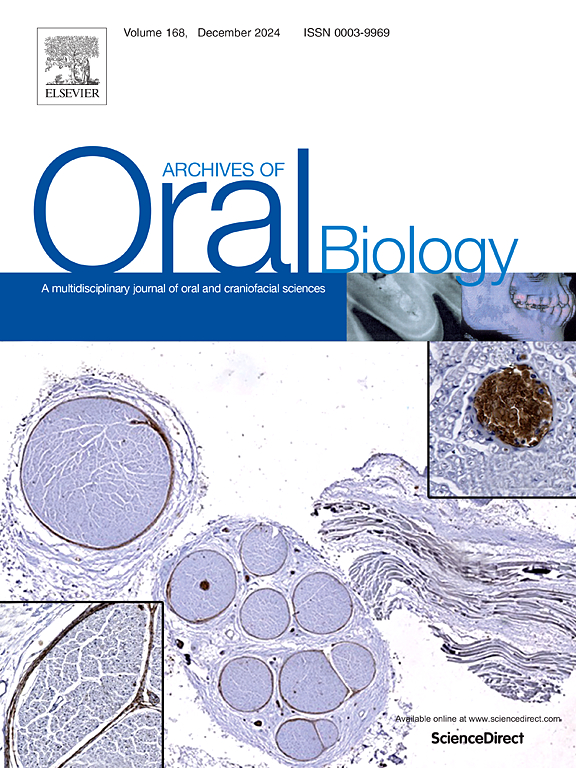Influence of salivary tumor necrosis factor alpha (TNF-α) concentration in patients with dysgeusia induced by antineoplastic chemotherapy: A case-control study
IF 2.2
4区 医学
Q2 DENTISTRY, ORAL SURGERY & MEDICINE
引用次数: 0
Abstract
Objectives
The aim of this study is to evaluate the role of TNF-α by investigating salivary levels and their influence on Dysgeusia in patients undergoing chemotherapy for breast tumors.
Design
Clinicopathological and sociodemographic data, taste test results and subjective taste analysis, salivary flow, quality of life, ECOG performance status, body mass index (BMI), body surface area and other side effects were recorded. The saliva obtained was stored at −80 ºC after addition of the protease inhibitor (Sigma; P2714–1BTLL), salivary TNF-α was measured using the TNF-alpha ELISA kit for human (ELH-TNFa-5, RayBio®) following the manufacturer's recommendation. The data was analyzed using Kolmogorov-Smirnov, Mann-Whitney, Spearman and Wilcoxon chi-square/Fisher's exact tests with all analyses adopted a 95 % confidence level in the SPSS for Windows software.
Results
The group without dysgeusia (WD) had a longer chemotherapy time than the group with dysgeusia (D) (p < 0.001) and a higher frequency of toxicity during CT than the D group (p = 0.012), the mean BMI increased slightly from 28.16 ± 5.34–28.30 ± 5.39 (p = 0.016), an increase which only occurred in the WD patients (p = 0.030) and not in the D patients (p = 0.106). There was a correlation with taste parameters, with an inversion between salivary TNF-α levels and the taste test (p = 0.033, r = -0.288). In the control group, salivary TNF-α concentration was directly correlated with VAS scale scores (p = 0.044, r = 0.266).
Conclusions
The increase in salivary TNF alpha had a direct impact on gustatory tests, and the development of dysgeusia has a negative impact on the quality of life of patients undergoing antineoplastic treatment.
肿瘤坏死因子α (TNF-α)浓度对抗肿瘤化疗引起的咽咽障碍患者的影响:一项病例对照研究
目的通过研究乳腺肿瘤化疗患者唾液中TNF-α水平及其对难产的影响,探讨TNF-α的作用。设计记录临床病理和社会人口学数据、味觉测试结果和主观味觉分析、唾液流量、生活质量、ECOG表现状态、体重指数(BMI)、体表面积和其他副作用。加入蛋白酶抑制剂(Sigma;P2714-1BTLL),唾液TNF-α采用人TNF-α ELISA试剂盒(ELH-TNFa-5, RayBio®)检测。使用Kolmogorov-Smirnov、Mann-Whitney、Spearman和Wilcoxon卡方/Fisher精确检验对数据进行分析,所有分析在SPSS for Windows软件中采用95% %的置信水平。ResultsThe集团没有味觉障碍(WD)化疗较长时间比与味觉障碍组(D) (p & lt; 0.001)和更高频率的毒性在CT比D组(p = 0.012),平均BMI略微增加从28.16 ±5.34 - -28.30 ± 5.39 (p = 0.016),它只发生在WD患者增加(p = 0.030)而不是D患者(p = 0.106)。唾液TNF-α水平与味觉测试呈负相关(p = 0.033,r = -0.288)。对照组患者唾液TNF-α浓度与VAS评分直接相关(p = 0.044,r = 0.266)。结论唾液肿瘤坏死因子α升高对味觉测试有直接影响,而出现吞咽困难对接受抗肿瘤治疗的患者的生活质量有负面影响。
本文章由计算机程序翻译,如有差异,请以英文原文为准。
求助全文
约1分钟内获得全文
求助全文
来源期刊

Archives of oral biology
医学-牙科与口腔外科
CiteScore
5.10
自引率
3.30%
发文量
177
审稿时长
26 days
期刊介绍:
Archives of Oral Biology is an international journal which aims to publish papers of the highest scientific quality in the oral and craniofacial sciences. The journal is particularly interested in research which advances knowledge in the mechanisms of craniofacial development and disease, including:
Cell and molecular biology
Molecular genetics
Immunology
Pathogenesis
Cellular microbiology
Embryology
Syndromology
Forensic dentistry
 求助内容:
求助内容: 应助结果提醒方式:
应助结果提醒方式:


